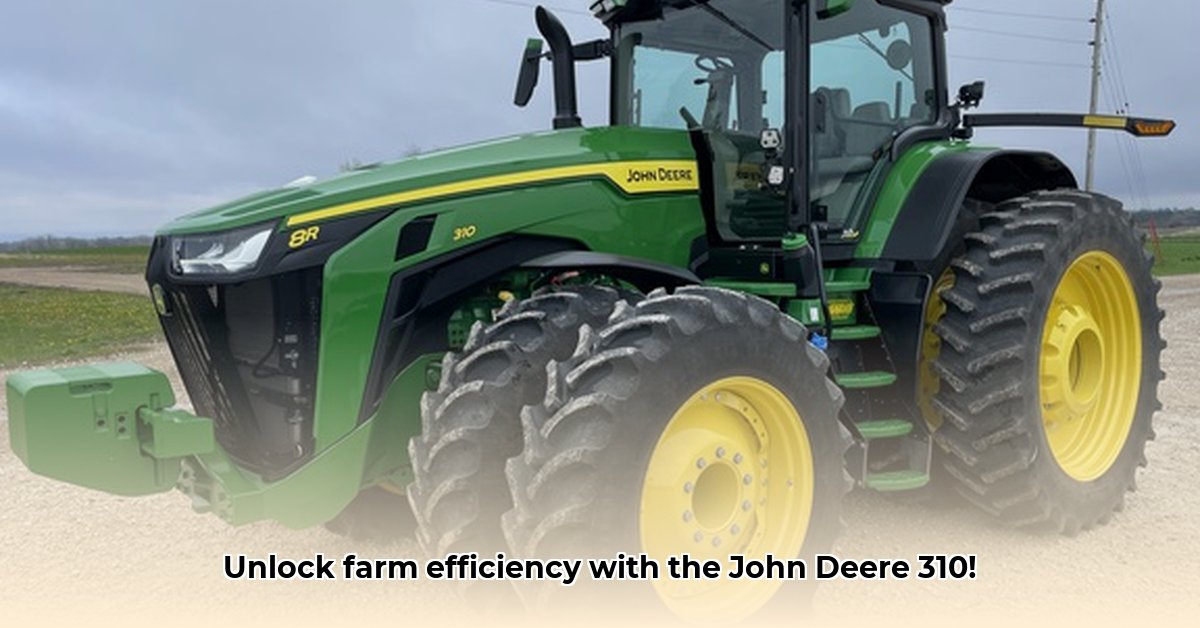
The John Deere 8R 310 tractor represents a significant advancement in agricultural technology, promising increased efficiency and sustainability. This article provides a comprehensive overview of its key features, benefits, and potential drawbacks, empowering farmers to make informed decisions about this substantial investment. It's not just about horsepower; it's about smart farming for a brighter future. For added comfort, check out these tractor seat covers.
Key Features Built for Efficiency
The John Deere 8R 310 boasts several key features designed to enhance productivity and reduce operational costs. AutoTrac™ assisted steering ensures perfectly straight rows, minimizing overlaps and maximizing fuel efficiency. This translates into more acreage covered in less time. Farmers can also choose between the e23™ PowerShift and IVT™ transmissions, offering flexibility to match the tractor's performance to specific tasks and varying terrain.
The Independent Link Suspension (ILS™) provides a smoother ride, reducing operator fatigue and improving overall productivity. This contributes to increased comfort and concentration throughout long working days. Additionally, customizable hydraulic systems seamlessly manage various implements, streamlining workflows and enhancing operational efficiency. The tractor's powerful engine provides ample power for demanding tasks. But does all this technology measure up in the field?
JDLink™: Real-Time Farm Management
JDLink™ telematics provides real-time monitoring of the tractor's performance, enabling proactive maintenance and troubleshooting. It's like having a digital supervisor constantly monitoring your operation. This remote access allows farmers to identify potential problems before they lead to costly downtime, helping to maintain operational efficiency. Think of it as constant, informed adjustments for maximum productivity. But how reliable is the system? Let's explore the pros and cons.
Is the John Deere 8R 310 Right for Your Farm? A Realistic Assessment
The John Deere 8R 310 is a considerable investment. While its advanced technology offers substantial long-term benefits, the initial cost necessitates careful consideration. "Before committing," advises Dr. Emily Carter, Agricultural Economist at Purdue University, "farmers should perform a thorough return on investment (ROI) analysis, considering their farm's size, specific needs, and budget." This includes factoring in ongoing maintenance and potential connectivity issues.
Addressing Potential Downsides: Connectivity and Maintenance
While JDLink™ offers significant advantages, its reliance on a reliable internet connection presents a potential challenge in areas with limited service. Thorough research of local internet infrastructure is crucial before purchasing. Furthermore, the advanced technology requires regular preventative maintenance, potentially increasing maintenance costs. A service contract might mitigate this risk.
Sustainability: Farming for a Greener Future
The John Deere 8R 310's precision agriculture capabilities contribute to sustainable farming practices. By optimizing resource use and reducing waste, it minimizes the environmental impact of agricultural operations. "The tractor's precision application features directly support ecologically responsible farming," states John Miller, Sustainability Manager at the National Farmers Union. This aligns perfectly with the growing global focus on climate-conscious agriculture.
Actionable Steps for Farms of All Sizes
The suitability of the John Deere 8R 310 depends on the scale of your farm:
Large-Scale Farms: Conduct a thorough ROI analysis. Pilot test key features. Optimize existing workflows. Long-term goals should include integrating full automation and leveraging data analytics to maximize yields.
Medium-Sized Farms: Explore diverse financing options. Prioritize essential features. Gradually integrate new technologies. Focus should be on enhancing overall efficiency and refining data-driven decision-making.
Small-Scale Farms: Investigate all available options. Maintain a strong emphasis on cost-effectiveness and practicality. Carefully select upgrades based on potential returns. Long-term goals center on evaluating sustainability and prioritizing cost-effective upgrades.
How to Reduce John Deere 8R 310 Tractor Fuel Consumption
Fuel costs are a significant expense for farmers. Optimizing fuel efficiency is critical for profitability and environmental responsibility. Here's how:
- Regular Maintenance: Preventative maintenance significantly improves fuel efficiency. Regular oil changes, filter replacements, and proper tire inflation are essential.
- Optimize Tractor Settings: Explore the tractor's settings to find the optimal balance between power and fuel efficiency. Experiment cautiously but thoroughly.
- Operator Skill and Technique: Smooth acceleration and braking, minimizing idling, and careful route planning reduce fuel consumption.
- Advanced Techniques: Variable rate application and precision farming technologies further optimize fuel use.
- Long-Term Fuel Savings: Investing in fuel-efficient tires and exploring alternative fuels are viable long-term strategies.
The John Deere 8R 310 represents a significant step forward in agricultural technology, offering tangible benefits for farms of all sizes. However, a comprehensive assessment of your specific needs and financial capabilities is paramount before making this important investment.
Three Pivotal Points:
- The 8R 310's precision agriculture capabilities significantly reduce resource waste and environmental impact.
- JDLink™ provides real-time data for proactive maintenance and improved operational efficiency, but requires reliable internet access.
- A thorough ROI analysis, considering initial cost, maintenance, and long-term benefits, is crucial before purchase.